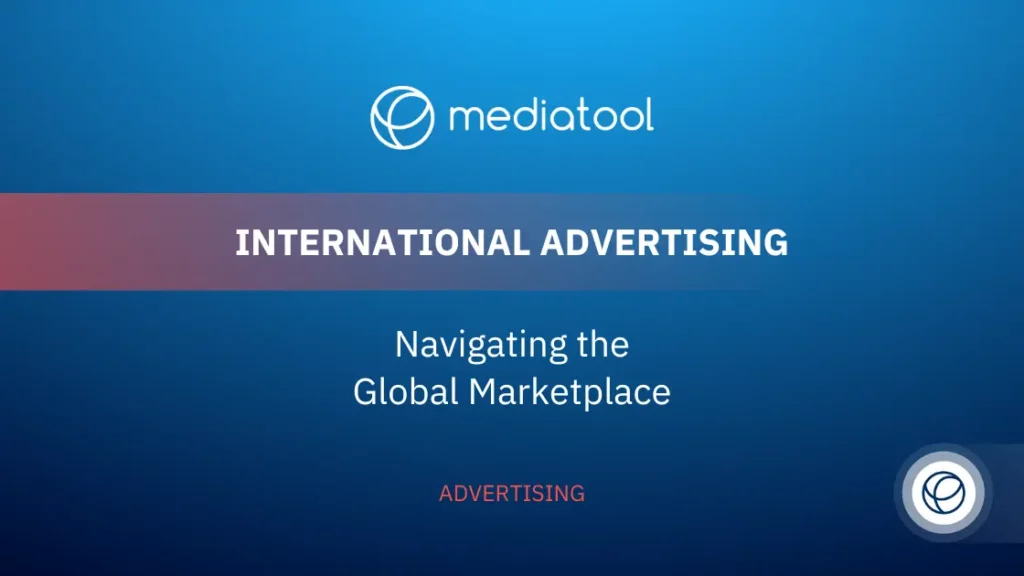Navigating international advertising can be daunting, with the challenge of connecting to a global audience while honoring local nuances. Yet, embracing this complexity opens doors to unparalleled opportunities.
This article guides mastering international advertising, from understanding diverse markets to leveraging digital advancements. Here, we’ll explore strategies that ensure your brand resonates worldwide, promising a journey toward successful global engagement.
What is International Advertising?
International advertising is a dynamic and essential facet of the global marketing landscape. It involves creating and distributing ad campaigns across multiple countries.
The aim? To capture the attention of target audiences around the world.
This approach isn’t just about translating ads into other languages but tailoring messages to resonate across different cultural contexts. International advertising is essential in building a global image for brands, making it a cornerstone of any robust international marketing strategy.
With the mobile advertising market valued at over $100 billion annually, it’s clear that digital and mobile platforms play a crucial role in the strategies employed by businesses to connect with consumers globally. International advertising is essential in building a global image for brands, making it a cornerstone of any robust international marketing strategy.
Objectives of International Advertising

Expanding Brand Recognition Globally
The aims of international advertising are broad, going beyond just immediate sales. Its primary mission is to inform and sway a diverse audience, effectively overcoming cultural and language barriers.
This aspect of advertising is essential for companies looking to boost their brand recognition worldwide. It’s all about growth through universal appeal, making a brand a well-known entity in numerous countries.
By highlighting shared values and using widely recognized symbols, these campaigns strive to create a feeling of community and connection among consumers from different cultures.
Interestingly, social media plays a critical role in this endeavor. 89% of consumers say they will buy from a brand they follow on social media, and 84% would choose these brands over their competitors. This demonstrates the significant impact of social media engagement on global brand recognition and consumer preference.
Ultimately, international advertising does more than just promote products; it’s a strategic effort to share a brand’s core message and vision with the world.
Building Cross-Cultural Connections
At its essence, international advertising consists of crafting ads that transcend local customs to appeal to consumers in various countries. This task, often undertaken by advertising agencies, involves a sophisticated communication process designed to resonate across different cultural contexts.
The success of such campaigns hinges on their ability to navigate the complex cultural landscape of each market, establishing personal and inclusive connections.
International advertising aims to deliver messages that speak to a global audience while honoring each region’s unique cultural dynamics, a fundamental challenge to the practice.
Challenges of International Advertising
Navigating Cultural Nuances and Regulations
Launching an international advertising campaign introduces formidable challenges, particularly in balancing global consistency and local relevance. One significant obstacle is understanding and respecting the cultural context of various markets.
Strategies that are effective in one country may be inappropriate or even offensive in another due to differing values, humor, and traditions.
Additionally, the legal and regulatory environment can vary significantly from one market to another, complicating the efforts of advertising agencies to execute global campaigns seamlessly.
Media Strategy Across Diverse Markets
Selecting the right media channels constitutes another critical challenge. The popularity and accessibility of specific platforms vary significantly across countries, affecting where and how a campaign should be executed.
This aspect of international advertising demands a thorough understanding of local media landscapes and strategic ad spend decisions to ensure that messages reach their intended audience effectively.
Despite these hurdles, the potential for engaging with consumers in international markets and expanding into new territories underscores the critical role of international advertising in the worldwide industry.
International advertising represents a concerted effort to bridge cultural gaps, facilitated by advertising agencies that specialize in creating compelling communication strategies for a global audience. While navigating cultural nuances and adapting media strategies present significant challenges, the pursuit of establishing meaningful connections with consumers across international markets is a key endeavor for businesses looking to thrive in the global marketplace.
5 Key Steps to a Successful International Advertising Campaign
Launching an international advertising campaign involves understanding and adapting to the complexities of global markets.
Here, we break down the process into five actionable steps, emphasizing practical advice and clear strategies.
1. Market Research
Successful international advertising starts with detailed market research. This step is about getting to know the local culture, consumer behavior, and media habits in each target country.
It’s essential for tailoring messages that resonate with the local audience while keeping your brand’s global image intact. Through market research, companies can create ads that appeal to consumers in different countries, ensuring their international marketing efforts are both relevant and effective.
For instance, a brand like Coca-Cola customizes its advertising to reflect local preferences and traditions, showing how a deep understanding of diverse markets can enhance global campaigns. Yet, surprisingly, less than 40% of marketers are tapping into consumer research to guide their decisions. This shows a significant opportunity for brands to leverage detailed insights into consumer behavior to refine their international marketing strategies further.
2. Clear Objectives
Knowing what you want to achieve in each local market is key. Whether it’s increasing brand awareness or boosting sales for specific products, having clear objectives shapes your strategy and helps track success.
This focus enables you to use your advertising budget effectively, targeting efforts where they can have the most impact. In the realm of international advertising, setting objectives for each market allows a company to maintain a unified brand image while catering to local consumer needs.
3. Creative Adaptation
Adapting your campaign creatively to different cultures is essential. This step goes beyond translating your message into other languages; it involves adjusting your campaign to fit the cultural nuances of each country.
The aim is to keep your brand’s core message consistent but relevant and appealing to local audiences. This approach strengthens your connection with the audience by showing respect for their culture and preferences. The success of a global campaign hinges on this balance between universal brand messaging and local relevance.
4. Media Strategy
Choosing the correct media channels is key to effectively reaching your target audience. Since the media landscape changes significantly from one country to another, it’s vital to know where your audience is most active.
A strategic media plan makes sure your campaigns reach the right audience at the perfect time, ensuring your advertising budget has the biggest possible impact. By customizing your media strategy for each market, you can greatly improve the success of your global advertising efforts.
It’s worth noting that campaigns utilizing three or more channels achieve a purchase rate that’s 287% higher than those relying on a single channel. This statistic highlights the substantial benefits of a diversified media strategy, underlining the importance of spreading your advertising efforts across multiple channels to maximize effectiveness and reach.
5. Evaluation and Adjustment
Finally, continuously evaluating and adjusting your campaign is necessary for sustained success. This means keeping an eye on how your ads perform in different markets and tweaking your strategy based on what you learn.
The global market is always changing, and staying flexible allows you to adapt to new trends and consumer feedback. Regularly reviewing your campaign’s performance helps refine your approach, ensuring your international advertising remains effective over time.
Leveraging Digital Transformation in International Advertising

The onset of the digital era marks a significant shift in the landscape of international advertising, offering an array of new opportunities alongside notable challenges. This evolution demands that both companies and advertising agencies reevaluate and adapt their strategies to thrive in the rapidly changing digital environment, thus enhancing their effectiveness and reach across international markets.
Embracing Digital Platforms for Global Reach
The transformation brought about by digital media has fundamentally altered the approach to international advertising. Social media platforms, search engines, and digital marketplaces now form the backbone of the strategies that businesses employ to promote their products and services beyond their home country.
This shift towards digital channels underscores a pivotal change in how companies engage with global audiences, offering numerous advantages over traditional advertising methods.
One of the key benefits of digital advertising is the capacity for targeted advertising. Unlike the broad strokes used in traditional media, digital platforms allow businesses to tailor their advertising efforts to specific demographics, interests, and geographical areas.
This precision not only improves the effectiveness of advertising campaigns but also enhances the return on ad spend by ensuring that messages reach the most relevant audiences.
Projected ad spend in the advertising sector is expected to hit $1,088 billion in 2024. This staggering figure highlights the significant financial commitment businesses are making towards digital platforms, underlining the shift towards and the importance of digital channels in global marketing strategies.
The ability to engage with a global audience in a more cost-effective and efficient manner than ever before is one of the primary drivers behind this investment, lowering the barriers to entry for international advertising and enabling businesses of all sizes to participate in the global marketplace.
Real-time communication is another hallmark of digital advertising. Platforms such as social media allow for immediate interaction with consumers, enabling businesses to respond to trends, feedback, and consumer behaviors as they happen.
This agility helps companies to maintain a relevant and engaging presence in their target markets, fostering a closer relationship with their audience.
The digital landscape offers the ability to engage with a global audience in a more cost-effective and efficient manner than ever before. The barriers to entry that once limited international advertising to companies with significant budgets have been lowered, enabling even small and medium-sized enterprises to reach out to international markets.
This democratization of advertising has leveled the playing field, allowing more businesses to participate in the global marketplace.
Conclusion
International advertising is a powerful tool for brands looking to expand their reach across global markets. While it comes with its challenges, the potential to connect with customers around the world makes it a worthwhile endeavor.
Businesses can launch successful international marketing campaigns by understanding the local market, adapting messages creatively, and choosing the right media channels.
With a smart, optimistic approach, international advertising can drive growth, build brand loyalty, and establish a strong global presence.





